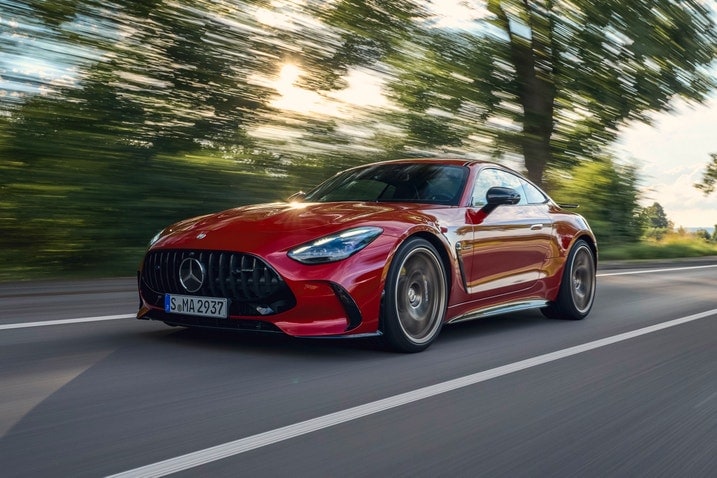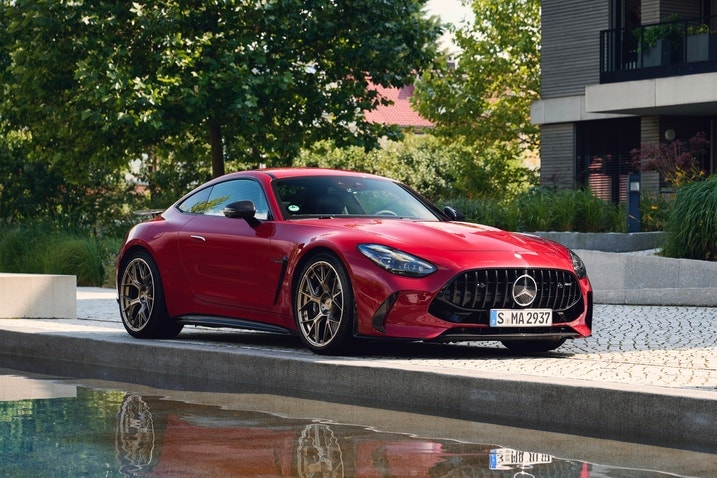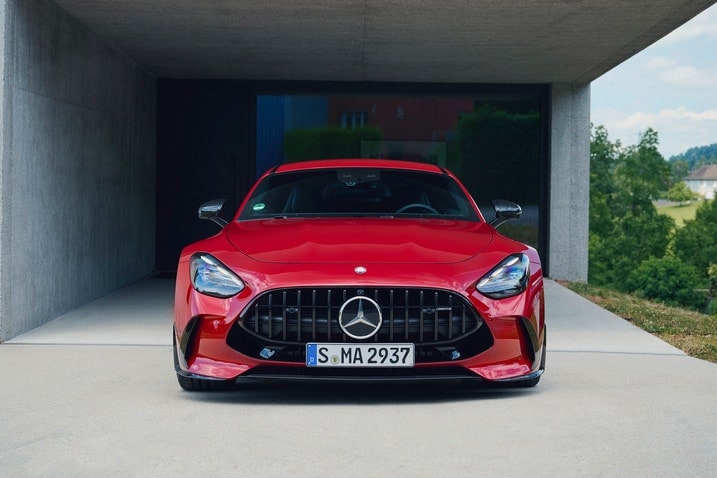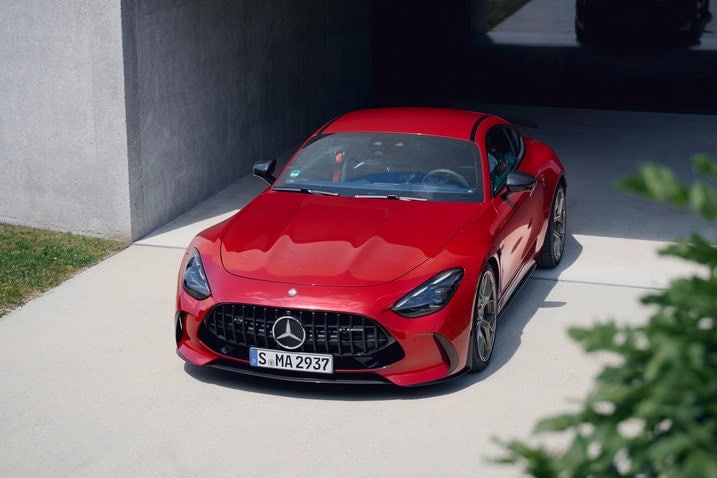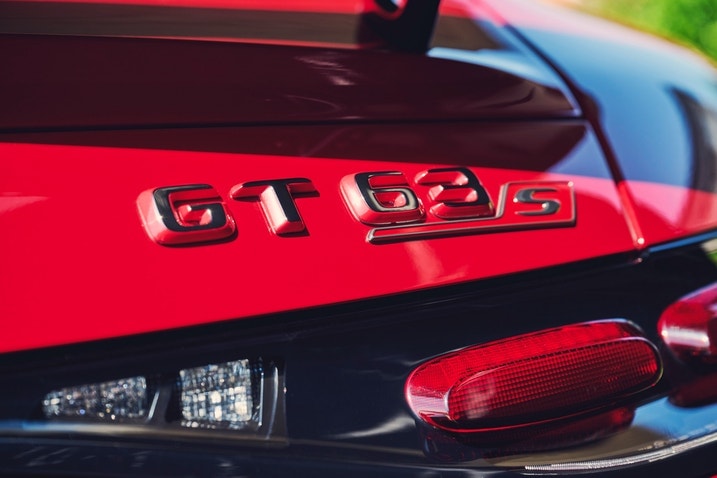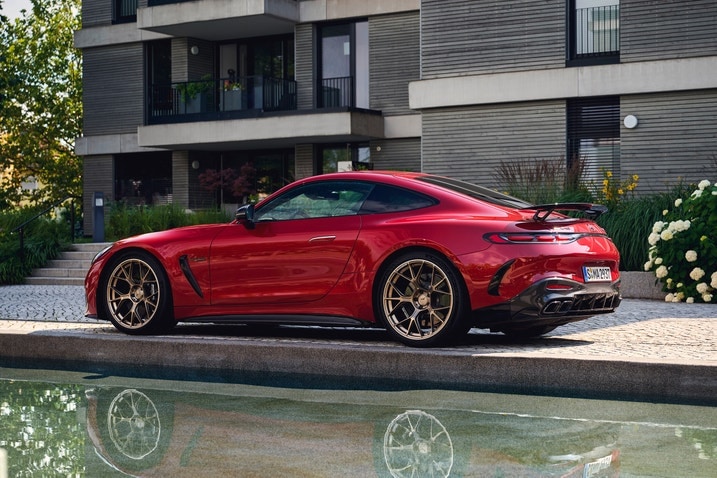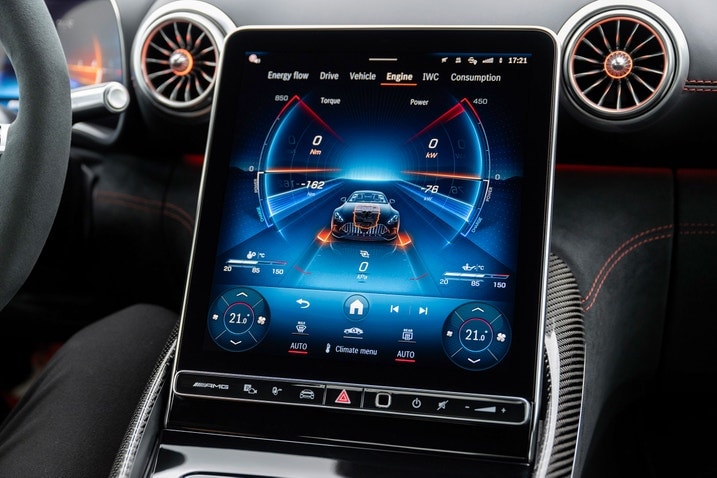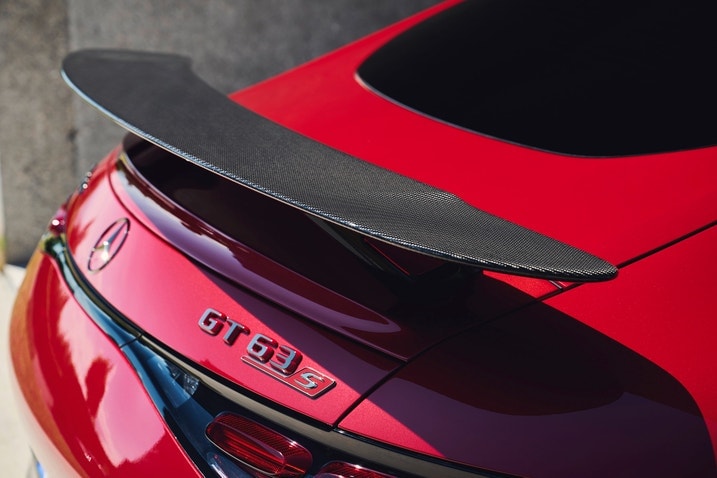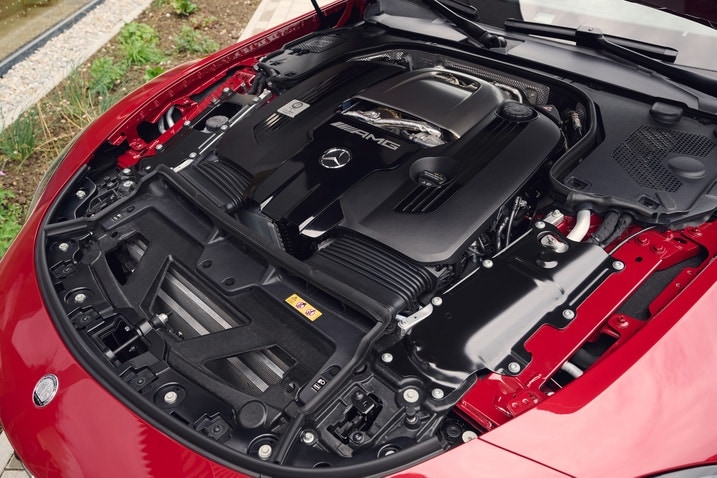
An electric motor at the rear axle combines with the V8 for a total system output of 805 hp and 1,047 lb-ft, more than double the torque output of the GT 55 and on par with cars like the Tesla Model S Plaid, Koenigsegg CC850 and, um, Ford F-250 Super Duty. The electric motor gets its juice from a small 4.8-kWh battery pack that, when charged, allows for a small amount of all-electric driving.
Power is sent to all four wheels through a nine-speed automatic transmission. With sticky Michelin Pilot Sport S 5 tires managing all of that power, AMG says the GT 63 S E Performance can go from 0 to 60 mph in a scant 2.7 seconds. That makes this coupe the quickest-accelerating production car AMG has ever produced. Yes, quicker than the Mercedes-AMG One, a road car that literally uses a modified Formula 1 engine.
The hybrid components of the powertrain are mostly there for performance, but it’s not all about speed and power. That 4.8-kWh battery allows for a short amount of all-electric driving. And we do mean short. Mercedes hasn’t announced EPA ratings for the E Performance, but expect less than 10 miles of all-electric driving. That’s far shorter than the range in the Mercedes-AMG S 63 E Performance, though that big sedan isn’t nearly as quick as this coupe.
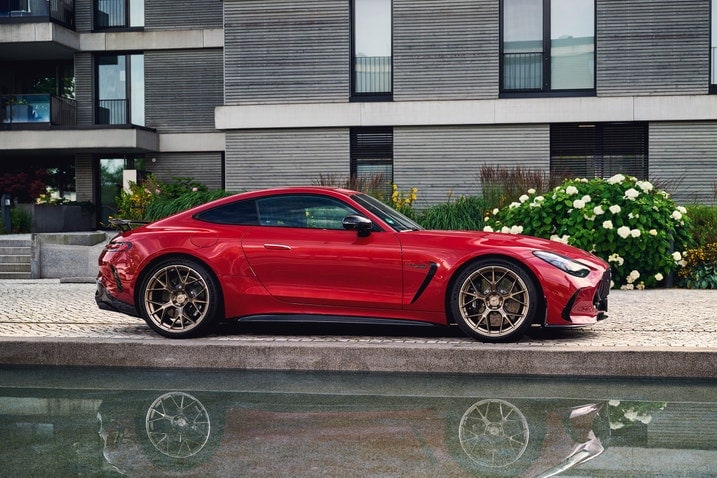
Effortless, endless speed
The acceleration delivered by the GT is nearly unparalleled on the road, with only the highest-caliber performance cars able to match or exceed it. There’s never a point at which the GT 63 feels short of power or out of breath. I had a few opportunities to open things up on Germany’s unrestricted autobahn, one of the few stretches of pavement where it’s really possible to exploit the car’s power. It takes little effort or time to get to triple-digit speeds, and with a long enough stretch of open air, the E Performance will top out at an electronically limited 199 mph.
On winding country roads near AMG’s headquarters in Affalterbach, the GT feels immense and unflappable. Passing slower motorists (e.g., farm tractors and the occasional Renault Twingo) requires little more than a small dip of the throttle. In Comfort mode, the transmission takes a second to downshift, but in any of the more dynamic modes (Sport, Sport+ and Race) the transmission drops a gear with little hesitation. Just point the wheel and hold on.
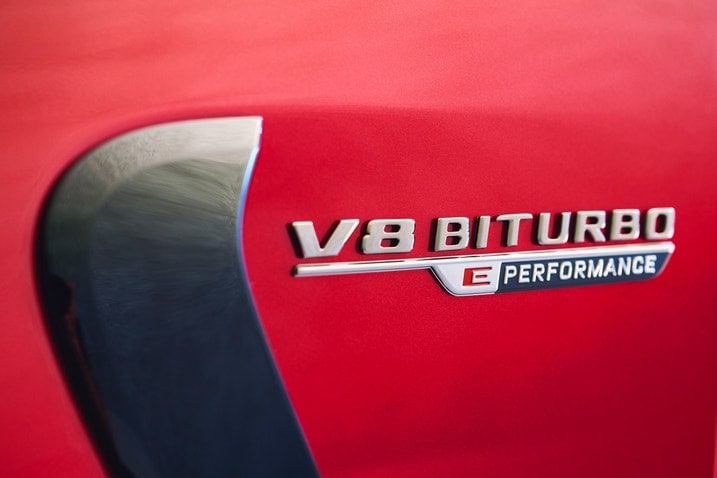
The powertrain might garner most of the attention, but the GT’s handling prowess shouldn’t be overlooked. Standard features include carbon-ceramic brakes, an adaptive suspension, active anti-roll bars and rear-axle steering. The car corners well on winding backroads, with little body roll and responsive steering. There’s only a mild amount of roll in corners, but the car still feels a bit big and heavy, not shrinking around you the way some other sports cars do. I wouldn’t call it fat or ponderous, just a bit hefty and not quite as nimble as something like a Porsche 911 Turbo S or a McLaren Artura.
The all-wheel-drive system and Michelin tires provide plenty of traction, aided by the rear-axle steering system. Below 60 mph, the rear wheels turn the opposite direction of the front for tighter turn-in. Above 60 mph, the rear wheels turn with the front for improved high-speed stability. It’s subtle and feels more natural than some past rear-axle steering systems, though it’s mostly helpful at speed. Trying to park the AMG GT requires a few moves as the turning radius is still quite large. Rear-axle steering effectively shortens a car’s wheelbase, but you can only compensate so much.
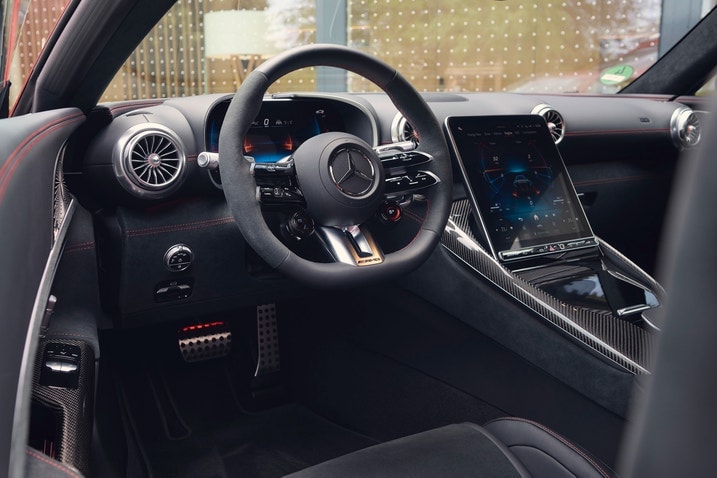
A rotary knob on the steering wheel will allow you to swap between various drive modes. There are the typical performance modes that increase throttle sensitivity, sharpen shifts, stiffen the suspension, and adjust stability control, but there are also modes that will force the car to run solely on electricity or hold the battery’s charge for later use. The GT packs a truly great-sounding V8, but it’s also nice being able to roll out of your driveway in the morning without waking all of the neighbors. The residents in the villages along my drive route probably appreciated the quiet nature, too.
Ride comfort, even with the adaptive suspension, is on the firm side of comfortable. While the GT never punishes, even in the sportiest setting, you always feel some of the road surface. Germany’s roads are generally excellent, especially compared to the streets around Edmunds’ Southern California headquarters. There’s not as much compliance in the suspension as there is with the GT’s twin, the Mercedes-AMG SL. The SL and GT are built on the same platform these days, and AMG tunes the SL more for comfort and touring and the GT more for sport and performance.
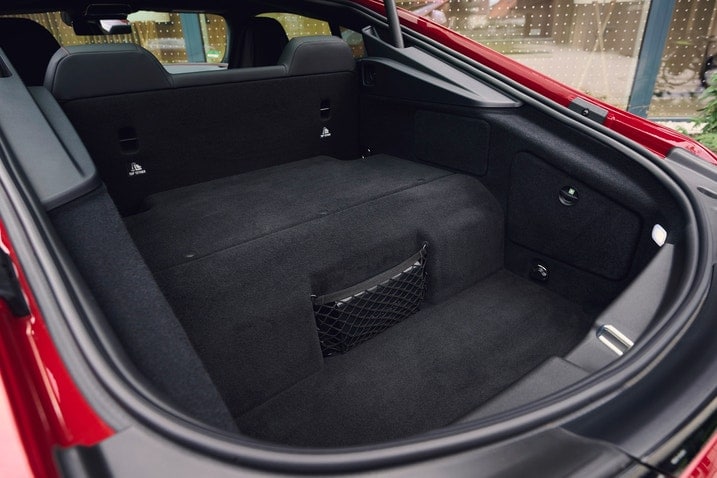
A premium, slightly compromised interior
The GT’s cabin is handsome and very well appointed, though it’s essentially the same as the one in the non-E Performance coupe. The seats offer plenty of adjustment for things like bolstering and lumbar, so most people should be able to find a comfortable position with a little fine-tuning. The seats are on the sporty side, but the padding is soft and plush enough that I didn’t feel stiff after a full day behind the wheel. The GT comes standard with two seats, though a rear seat is available as a no-cost option. It’s tight back there. Very tight, even for children, so you might be better off skipping the seat entirely and using the parcel shelf that comes standard.
And you’ll need that parcel shelf. Despite being minuscule by the standards of a hybrid or EV, the E Performance’s battery still takes up a sizable amount of space in the hatch. The regular AMG GT already has a huge cargo area for a coupe, so the cargo area isn’t totally compromised when the battery from the E Performance is shoved back there, but it’s worth keeping in mind.
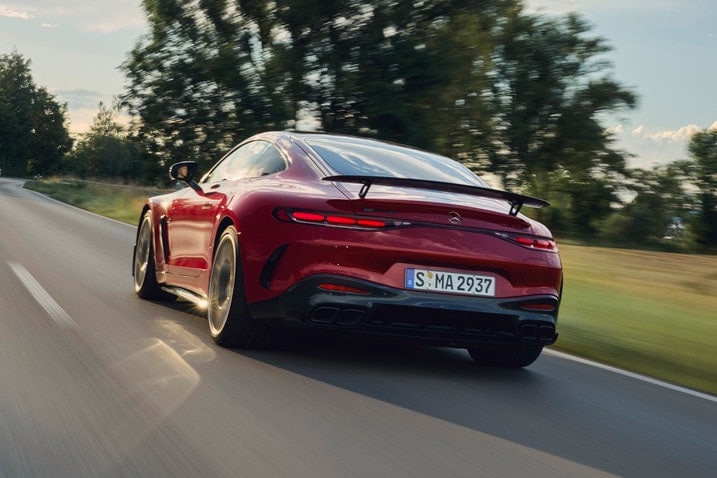
What about the competition?
It’s hard to name a direct competitor for the AMG GT 63 S E Performance as there are few plug-in hybrid performance cars. The McLaren Artura fits the bill more closely than most as it, too, uses a plug-in hybrid powertrain. McLaren’s V6 isn’t as powerful as AMG’s V8, and the mid-engine layout gives it a different character in both handling and design. It’s a little more exotic, but it’s not as quick or as spacious as the AMG.
If you’re willing to go without the hybrid powertrain, the Porsche 911 Turbo S offers similar performance at a similar price point. Like the McLaren, the placement of the engine (in this case behind the rear axle) gives the 911 a different look and feel from the Mercedes.
Edmunds says
The AMG GT coupe was already an extremely quick machine, but the addition of an electric motor turns things up by several degrees. With such paltry range, I wouldn’t say it’s a particularly great hybrid, but that’s not what it was really built for. It’s a performance car that happens to have a bit of electric assist, and by that standard it’s a winner. It’s not the sharpest or the most agile sports car out there, but the combination of a premium interior, excellent ride and handling, and some of the most thrilling acceleration you could ever experience makes it a car I won’t soon forget.
